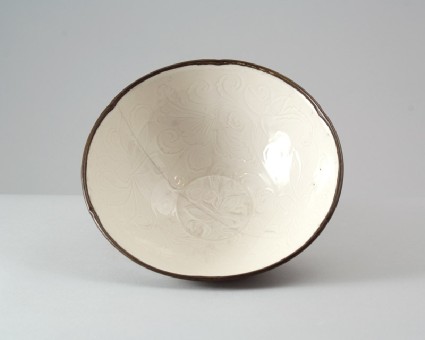The Barlow Collection
A select catalogue of the Barlow collection of Chinese Ceramics, Bronzes and Jades by the University of Sussex (published Sussex, 2006).

Publications online: 456 objects
White ware bowl with lotus decoration
- loan
-
Literature notes
In order to prevent thinly potted bowls such as this piece from warping and in order to save space in the kiln, the Ding kilns turned to firing bowls and dishes upside down. Standing on their rims, the pieces could be stacked in a stepped saggar, a ceramic firing container, which also saved the glazes from falling wood ash. The rims, which had to be wiped free of glaze before firing, to avoid adherence to the sagger, were then mounted in copper to hide the rough edge.
The rounded bowl has wide open sides with six indents on the outside, corresponding to shallow lobes in the slightly flared rim, and stands on a straight narrow foot. The inside is incised with a lotus scroll with two large blooms, two leaves and two stems of arrow-head, surrounded by foliate scrollwork, with a further, smaller bloom, about to turn into a pod, in the centre. The tool for the engraving was held at an angle to make the design stand out in shallow relief, and details have been added by combing. The outside is plain. The off-white body bears a transparent ivory-tinged glaze with somewhat darker ‘tears’ on the outside, the footring is partly unglazed, the rim, presumably free of glaze, is bound in a thick copper rim mount. -
Details
- Associated place
-
Asia › China › Hebei province › Ding kilns (place of creation)
- Date
-
11th - 12th century (1001 - 1200)
Song Dynasty (AD 960 - 1279)
- Material and technique
- stoneware, thrown, with incised and combed decoration under a white glaze; copper rim; glazed base
- Dimensions
-
8.2 cm (height)
20.8 cm (diameter)
- Material index
- Technique index
- Object type index
- No. of items
- 1
- Credit line
- Lent by the Sir Alan Barlow Collection Trust.
- Accession no.
- LI1301.78
-
Further reading
University of Sussex, and Arts and Humanities Research Council, The Barlow Collection, supervised by Regina Krahl, Maurice Howard, and Aiden Leeves (Sussex: University of Sussex, 2006), no. C49
Glossary (2)
glaze, stoneware
-
glaze
Vitreous coating applied to the surface of a ceramic to make it impermeable or for decorative effect.
-
stoneware
Ceramic material made of clay which is fired to a temperature of c.1200-1300⁰c and is often buff or grey in colour.
Location
-
- currently in research collection
Objects are sometimes moved to a different location. Our object location data is usually updated on a monthly basis. Contact the Jameel Study Centre if you are planning to visit the museum to see a particular object on display, or would like to arrange an appointment to see an object in our reserve collections.
Publications online
-

The Barlow Collection
In order to prevent thinly potted bowls such as this piece from warping and in order to save space in the kiln, the Ding kilns turned to firing bowls and dishes upside down. Standing on their rims, the pieces could be stacked in a stepped saggar, a ceramic firing container, which also saved the glazes from falling wood ash. The rims, which had to be wiped free of glaze before firing, to avoid adherence to the sagger, were then mounted in copper to hide the rough edge.
The rounded bowl has wide open sides with six indents on the outside, corresponding to shallow lobes in the slightly flared rim, and stands on a straight narrow foot. The inside is incised with a lotus scroll with two large blooms, two leaves and two stems of arrow-head, surrounded by foliate scrollwork, with a further, smaller bloom, about to turn into a pod, in the centre. The tool for the engraving was held at an angle to make the design stand out in shallow relief, and details have been added by combing. The outside is plain. The off-white body bears a transparent ivory-tinged glaze with somewhat darker ‘tears’ on the outside, the footring is partly unglazed, the rim, presumably free of glaze, is bound in a thick copper rim mount.
Notice
Object information may not accurately reflect the actual contents of the original publication, since our online objects contain current information held in our collections database. Click on 'buy this publication' to purchase printed versions of our online publications, where available, or contact the Jameel Study Centre to arrange access to books on our collections that are now out of print.
© 2013 University of Oxford - Ashmolean Museum




